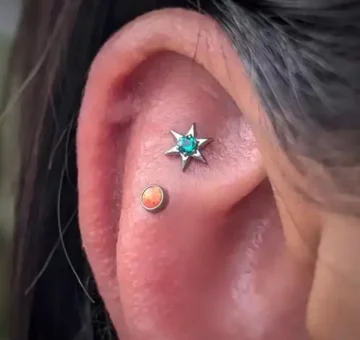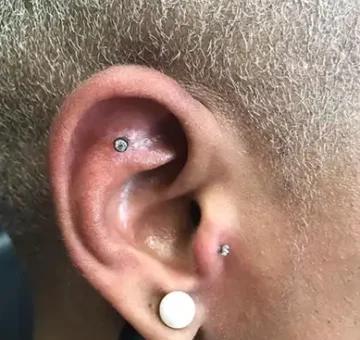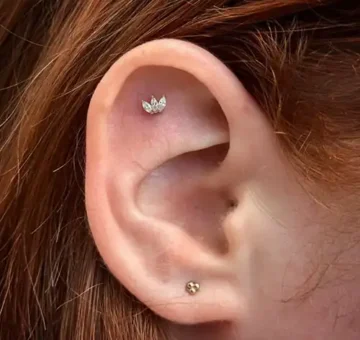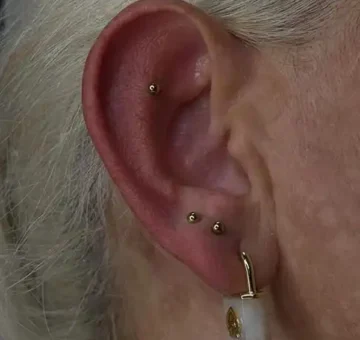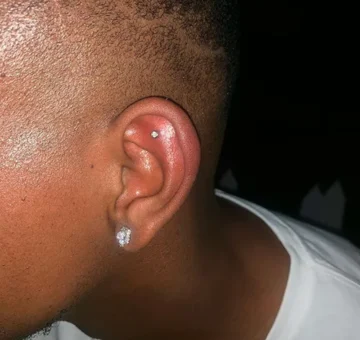Flat Piercing in Nairobi, Kenya
A flat piercing is an ear cartilage piercing located on the flat area of the upper ear, near the outer rim. Unlike traditional lobe piercings, it involves piercing through the flat, tougher cartilage, which is why it tends to be more painful and requires a bit more healing time.
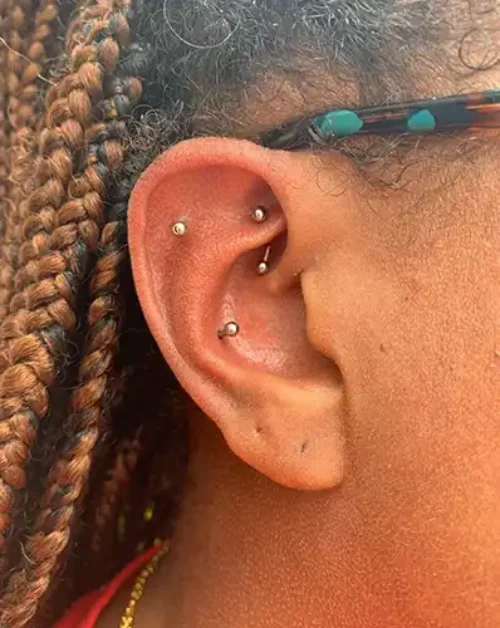
Flat Piercing
Here are some details about flat piercings:
- Pain Level: Moderate to high due to the cartilage. Pain tolerance varies, but it’s usually more uncomfortable than lobe piercings.
- Healing Time: It typically takes around 6-9 months to fully heal, but this can vary. Careful aftercare is essential to avoid infection.
- Jewelry: Common jewelry types for flat piercings include flat back studs, barbells, and hoops. Initial jewelry is usually something simple to allow healing.
- Aftercare: Cleaning with a saline solution twice daily is recommended. Avoid touching, twisting, or sleeping on the piercing to reduce the risk of irritation or infection.
Flat Piercing Procedure
A flat piercing procedure involves puncturing the flat area of cartilage on the upper ear. Here’s a step-by-step overview of what to expect:
- Consultation
– Our piercer will assess your ear anatomy to ensure the flat area is suitable for piercing.
– You’ll choose your initial jewelry, usually a flat-back stud, which is less likely to cause irritation during the healing process. - Preparation
– Sterilization: Our piercer will clean the area thoroughly with an antiseptic solution to prevent infection.
– Marking: Our piercer will mark the exact spot on the flat of your ear where the piercing will be placed. You can review this placement before proceeding.
– Sterile Environment: The tools and jewelry used are sterile to minimize the risk of infection. - Piercing
– Needle: The flat piercing is done using a hollow, sterilized needle specifically designed for body piercings. It’s inserted in one smooth motion through the marked spot on the cartilage.
– Pain: Since cartilage is tougher than soft tissue, you’ll feel pressure and discomfort, but the actual piercing process is usually quick.
– Jewelry Insertion: After the needle is removed, our piercer will insert the jewelry (usually a stud or small barbell) through the hole. - Post-Piercing
– Cleaning: Our piercer will clean the area again and provide you with detailed aftercare instructions.
– Bandage: Depending on the location, they may apply a small bandage or leave it exposed. - Aftercare
Follow the aftercare guidelines provided by your piercer. Typically, you’ll need to:
– Clean the area with saline solution twice a day.
– Avoid touching, twisting, or sleeping on the piercing.
– Keep the area dry and avoid submerging it in water (like pools or baths) during the healing process.
The procedure is generally safe if performed by a professional, and proper aftercare reduces the risk of complications.
Considerations before getting a Flat Piercing
Before getting a flat piercing, it’s essential to consider several factors to ensure it’s the right decision for you. Here’s a list of key considerations:
- Pain Tolerance
– Flat piercings involve piercing through cartilage, which is more painful than lobe piercings. The area is also more sensitive and can take longer to heal.
– Be prepared for discomfort both during the procedure and in the days following. - Healing Time
– Healing Period: It typically takes 6-9 months to fully heal, though it could take longer depending on your body and aftercare routine.
– Extended Care: During this period, you’ll need to maintain a strict cleaning routine, and you might experience swelling, tenderness, or slight discomfort. - Aftercare Commitment
– Daily Cleaning: You’ll need to clean the piercing twice a day with a saline solution. Touching or twisting the jewelry is discouraged, as it can irritate the piercing or introduce bacteria.
– Avoid Sleeping on the Piercing: Sleeping on your side can cause irritation, so you might need to adjust your sleeping habits.
– No Swimming: Avoid swimming pools, hot tubs, and submersion in bodies of water until fully healed, as these can increase the risk of infection. - Work or Lifestyle
– Work Environment: If you have a job that requires wearing helmets, headsets, or anything that touches the ears, this might affect your comfort or delay healing.
– Sports/Activities: If you participate in sports or activities where your ear could be bumped, it could cause complications, prolong healing, or even result in infection or rejection of the piercing. - Piercing Shop Hygiene
– Research the Studio: Ensure that the piercing studio is reputable, clean, and uses sterile equipment. Look for positive reviews and check for proper certification.
– Experienced Piercer: Make sure the piercer is experienced, especially with cartilage piercings, which require skill to avoid complications like improper placement or scarring. - Jewelry Selection
– Initial Jewelry: Choose high-quality, hypoallergenic materials like titanium, surgical steel, or gold. These are less likely to cause allergic reactions or infections.
– Size and Comfort: The initial jewelry should allow for some swelling, so avoid tight jewelry. After healing, you can change it to something more snug or decorative. - Risk of Complications
– Infections: Cartilage piercings are more prone to infections because they have less blood flow compared to lobe piercings. If an infection occurs, it can be more difficult to treat.
– Keloids or Hypertrophic Scarring: Some people are prone to forming scar tissue or keloids after cartilage piercings. Discuss this risk with your piercer, especially if you have a history of keloid formation. - Cost
– Piercing Fees: Cartilage piercings like flat piercings can be more expensive than lobe piercings due to the complexity of the procedure. Be sure to factor in the cost of the piercing, the initial jewelry, and any aftercare products.
– Follow-up Costs: You might need to return for check-ups or to switch jewelry once the healing process is complete. - Aesthetic and Commitment
– Long-term Aesthetic: Consider how the flat piercing fits with your overall style and any other piercings you may have. Flat piercings can be more visible depending on the size and type of jewelry used.
– Commitment to Healing: Given the long healing time and potential discomfort, be sure you’re prepared for the commitment to aftercare and the temporary inconveniences of the healing process.
By considering these factors, you can make a more informed decision about whether a flat piercing is the right choice for you.
Flat Piercing Pain and Healing
A flat piercing involves puncturing the flat cartilage area of the ear, which makes it a bit more painful than lobe piercings and requires a longer healing period. Here’s a breakdown of the pain and healing process:
Pain Level
- Initial Pain: Since flat piercings go through cartilage, which is thicker and less flexible than the soft tissue in the ear lobe, the pain is typically more intense. Many describe the pain as a sharp pinch followed by throbbing.
- Pain During Procedure: The actual piercing is quick, and any significant pain usually lasts only a few seconds. However, you may feel a bit more pressure than you would with a lobe piercing.
- After the Procedure: It’s common to experience soreness, tenderness, and throbbing in the days following the piercing. This pain usually subsides over the first week but may flare up again if the piercing is bumped or irritated.
Healing Process
Healing Time: Flat piercings generally take 6-9 months to fully heal, but it can sometimes take up to a year depending on your body’s healing speed and how well you care for the piercing.
Healing Stages:
- First Week: The initial pain and swelling should start to decrease, but the area may remain sensitive. During this time, it’s crucial to avoid touching or twisting the jewelry.
- 1-3 Months: The piercing will still be healing, and it’s normal for it to feel tender or irritated occasionally. Continue regular cleaning and avoid sleeping on the pierced side.
- 3-6 Months: At this point, the piercing should start feeling more stable, though it may still be sensitive to touch or pressure.
- 6+ Months: The piercing should be nearly or fully healed, but any irritation or mishandling could still cause issues.
Flat Piercing Aftercare
Proper aftercare is crucial for the successful healing of a flat piercing. Since it’s a cartilage piercing, it requires more attention than lobe piercings to prevent complications like infection, irritation, or scarring. Here’s a detailed guide on how to care for a flat piercing:
- Cleaning Routine
Saline Solution: Clean your piercing twice a day with a sterile saline solution or a homemade mixture (¼ teaspoon of non-iodized sea salt dissolved in a cup of warm distilled water).
– Use a clean cotton pad or gauze to gently dab the saline solution onto the piercing site.
– Let it soak for a few minutes to loosen any crusted discharge around the piercing.
– Afterward, gently pat the area dry with a clean paper towel. Avoid using cloth towels as they can harbor bacteria. - Avoid Touching the Piercing
– Hands Off: Do not touch the piercing or twist the jewelry unless you’re cleaning it. Touching it with unwashed hands can introduce bacteria, increasing the risk of infection.
– Leave the Jewelry in Place: Don’t attempt to change the jewelry until the piercing is fully healed, which can take up to 9 months. Changing the jewelry too early can irritate the wound and delay healing. - Managing Swelling and Irritation
– Cold Compress: If the piercing is swollen, use a cold compress or ice pack wrapped in a cloth to reduce swelling.
– Avoid Over-the-Counter Medications: Stick to acetaminophen (Tylenol) for pain relief instead of ibuprofen or aspirin, which may increase the risk of bleeding. - Sleep Position
– Don’t Sleep on the Piercing: Avoid sleeping on the pierced side to prevent irritation. Use a travel pillow or a donut-shaped pillow to keep pressure off the area while sleeping.
– Pillow Hygiene: Change pillowcases frequently to keep the piercing free from bacteria that can accumulate on bedding. - Avoid Submersion in Water
– No Swimming: Avoid swimming pools, hot tubs, lakes, or any bodies of water during the healing process, as they can introduce harmful bacteria to the piercing site.
– Keep it Dry: Try to keep the piercing as dry as possible after cleaning. If it gets wet (e.g., in the shower), gently pat it dry with a clean paper towel. - Be Cautious of Hair, Clothing, and Accessories
– Watch for Snags: Be careful when brushing your hair, taking off clothes, or wearing headphones and hats. Any tugging or pressure can cause trauma to the piercing and lead to irritation or even migration.
– Loose Clothing: Wear loose clothing around the area to avoid putting pressure on the piercing. - No Products on the Piercing
– Avoid Harsh Products: Don’t use alcohol, hydrogen peroxide, or ointments like Neosporin on the piercing, as these can irritate the skin and slow down the healing process.
– Keep it Chemical-Free: Avoid using hair products, makeup, or skincare products around the piercing area. - Monitor for Infections
– Signs of Infection: Watch for signs of infection, such as increased redness, swelling, yellow or green discharge, throbbing pain, or warmth around the area. If you notice any of these, consult a piercer or a healthcare professional immediately.
– Do Not Remove the Jewelry: If you suspect an infection, do not remove the jewelry, as this can trap bacteria inside the piercing. Instead, visit a professional for advice. - Be Patient
– Healing Takes Time: Cartilage piercings, especially flat piercings, can take up to 9 months to a year to fully heal. Even if the outside appears healed, the inside might still be healing, so continue with your aftercare routine for the full duration. - Seek Professional Help for Issues
– Bumps or Keloids: If you notice a bump or keloid forming, Contact Us for advice on how to reduce it. We may suggest using a saline soak or a chamomile compress.
– Consultations: If you experience unusual pain, prolonged swelling, or suspect a complication, visit your piercer for a consultation. Avoid attempting to treat it yourself.
By sticking to these aftercare guidelines, you can promote healthy healing and reduce the chances of complications with your flat piercing.
Flat Piercing Jewelry
The choice of jewelry for a flat piercing is essential for comfort, healing, and aesthetics. Here’s a guide to help you choose the right jewelry for your flat piercing:
Types of Jewelry
- Flat Back Studs: These are the most common choice for flat piercings, especially during the healing period. They feature a flat disk at the back, which sits comfortably against the cartilage and reduces irritation.
– Advantages: Minimal movement, less pressure on the back of the ear, and reduced risk of snagging.
– Disadvantages: May be harder to change without help after healing. - Labret Studs: Similar to flat back studs, but with a threaded ball on the front and a flat disk at the back. They’re commonly used for cartilage piercings and are easy to wear.
- Barbells: Small straight barbells can also be used for flat piercings, offering a slightly different look from studs.
– Advantages: Versatile and easy to clean.
– Disadvantages: May be bulkier than studs, which can affect comfort during healing. - Hoops and Rings: Once the piercing is fully healed (after 6-9 months), hoops or captive bead rings can be worn. These provide a stylish, edgy look but are not recommended during the initial healing process.
– Advantages: Unique aesthetic; versatile styles.
– Disadvantages: More prone to snagging, irritation, and movement, which can affect healing.
Materials for Jewelry
Choosing the right material is critical for preventing allergic reactions and ensuring proper healing. The best materials include:
- Titanium: Hypoallergenic and biocompatible, titanium is one of the safest materials for piercings, especially for those with sensitive skin or metal allergies.
– Advantages: Lightweight, corrosion-resistant, and less likely to cause irritation or allergic reactions.
– Disadvantages: More expensive than other materials. - Surgical Steel: A popular choice for body jewelry. Surgical steel is durable, smooth, and generally safe for most people.
– Advantages: Affordable, strong, and resistant to corrosion.
– Disadvantages: May contain trace amounts of nickel, so it’s not suitable for people with severe metal allergies. - Niobium: Similar to titanium in terms of biocompatibility, niobium is another excellent choice for those with sensitive skin.
– Advantages: Hypoallergenic and less expensive than titanium.
– Disadvantages: Less widely available than titanium or steel. - Gold (14k or higher): Real gold (14k or higher) is another option for flat piercing jewelry. Ensure it’s solid gold, not gold-plated, as plating can wear off and expose underlying metals, leading to irritation.
– Advantages: Aesthetic appeal and hypoallergenic when 14k or higher.
– Disadvantages: Expensive and can be soft, making it more prone to damage over time. - PTFE/Bioplast: A flexible, non-metal option that’s ideal for those who have metal sensitivities or for certain situations like MRIs or pregnancy.
– Advantages: Flexible, lightweight, and biocompatible.
– Disadvantages: May not be as durable or visually appealing as metal options.
Size of Jewelry
- Gauge: Most flat piercings are done with a 14-gauge or 15-gauge needle. The gauge refers to the thickness of the jewelry. It’s important to choose the correct gauge, as wearing jewelry that’s too thick or too thin can cause irritation or affect healing.
- Length: The length of the jewelry should account for some swelling, especially during the initial healing phase. After swelling goes down, your piercer may recommend downsizing the jewelry to prevent movement and ensure a snug fit.
Jewelry Styles
- Minimalist: Many people prefer minimalist jewelry for flat piercings, such as small studs or tiny barbells, for a subtle, sleek look.
- Decorative: Once the piercing is healed, you can experiment with more decorative pieces, including gem-studded or shaped studs (stars, hearts, or flowers), depending on your style preference.
When to Change Jewelry
- Wait Until Fully Healed: It’s crucial not to change the jewelry until the piercing is fully healed, which can take 6-9 months. Changing it prematurely can disrupt the healing process, lead to infections, or cause the piercing to close.
- Seek Help from a Piercer: If you’re unsure how to change the jewelry or if it feels difficult to remove, it’s best to go back to your piercer for assistance, especially with flat back studs, which can be tricky to change on your own.
Custom Jewelry
For a unique look, some of our jewelers offer custom jewelry designs specifically made for cartilage piercings. These can include intricate designs, multiple gemstones, or shapes tailored to fit your ear’s anatomy.
By choosing the right type, material, and size of jewelry for your flat piercing, you can ensure a more comfortable healing process and achieve the aesthetic you want.
Cost of a Flat Piercing in Nairobi, Kenya
The cost of a flat piercing can vary depending on several factors, including the location, the piercer’s experience, and the type of jewelry you choose. Here’s a breakdown of what to expect:
- Base Piercing Fee
– General Range: The cost of a flat piercing typically ranges between Ksh. 1,500 and Ksh. 3,000
– Studio Reputation: Higher-end piercing studios or those with more experienced piercers may charge more. Well-known studios in major cities could have prices on the higher end of the spectrum, while smaller or less renowned shops may charge less. Rebel Inks Tattoos, Tattoo Removal, and Body Piercings Parlour is located in the heart of the Central Business Disrict (CBD) in Nairobi, Kenya, and is easily accessible to both locals and foreigners in the country - Jewelry Cost
Starter Jewelry: The initial jewelry is usually included in the price, but some studios charge separately depending on the material and style you choose. Jewelry prices can vary widely based on the quality and material:
– Surgical Steel: Ksh. 200–Ksh. 300
– Titanium: Ksh. 500–Ksh. 1,000
– Niobium: Ksh. 800–Ksh. 1,500
– Gold (14k or higher): Ksh. 3,000–Ksh. 5,000 - Upgrades: If you opt for more decorative or custom jewelry, you may pay extra.
- Aftercare Products
Some studios may offer or recommend aftercare products like saline sprays or solutions, which can add an additional Ksh. 300–Ksh. 500 to the cost. - Follow-Up Appointments
Jewelry Downsizing: After the swelling subsides, some of our piercers recommend switching to smaller jewelry. If this isn’t included in the initial fee, expect to pay around Ksh. 300 –Ksh. 1,000 for a follow-up visit, plus the cost of the new jewelry.
Estimated Total Cost:
- Low End: Around Ksh. 1,500–Ksh. 2,500 (basic piercing with surgical steel jewelry).
- High End: Around Ksh. 3,000 –Ksh. 5,000 (piercing with high-end or custom jewelry, plus aftercare products).
It’s essential to prioritize quality and hygiene over price when choosing a studio and piercer to ensure safety and proper healing.
Flat Piercing Price Breakdown Table
Component / Service | Estimated Cost (KSh) | Details / Notes |
Base Procedure Fee | 1,500 – 3,000 | Depends on studio reputation and piercer expertise |
Starter Jewelry (Surgical Steel) | 200 – 300 | Typically included |
Starter Jewelry (Titanium) | 500 – 1,000 | Hypoallergenic upgrade option |
Starter Jewelry (Niobium) | 800 – 1,500 | Premium hypoallergenic option |
Starter Jewelry (Gold 14K+) | 3,000 – 5,000 | High-end aesthetic choice |
Aftercare Kit (saline, sprays) | 300 – 500 | May be included or sold separately |
Downsizing / Follow-up Visit | 300 – 1,000 | To adjust jewelry after swelling subsides |
Total (Basic Package) | 1,700 – 3,300 | Procedure + basic jewelry |
Total (With Titanium Jewelry + Aftercare) | 2,300 – 4,500 | Upgraded jewelry plus aftercare supplies |
Total (Gold Jewelry + Full Services) | 4,800 – 9,500 | High-end aesthetic & complete care package |
Possible side effects of Flat Piercing
While flat piercings are generally safe when done by a professional, they can have side effects and complications, especially if proper aftercare isn’t followed. Here are the most common side effects and potential risks:
- Swelling and Redness
– Normal Reaction: Mild swelling and redness are typical in the first few days or weeks after getting a flat piercing. It’s the body’s natural response to the piercing and usually subsides with time.
– Prolonged Swelling: If the swelling lasts longer than a couple of weeks or worsens, it could be a sign of irritation or infection. - Pain and Tenderness
– Initial Discomfort: Some pain or tenderness is expected, especially in the days following the procedure. Cartilage piercings tend to be more sensitive due to their location.
– Chronic Pain: If the pain persists for an extended period or worsens over time, it could indicate improper healing, infection, or jewelry that’s too tight. - Infection
– Symptoms: Infection is one of the most common risks of any piercing. Symptoms include excessive redness, swelling, warmth, throbbing pain, and yellow or green discharge.
– Treatment: Minor infections can often be treated with saline soaks and keeping the area clean, but more severe infections may require antibiotics. Always Contact Us if you suspect an infection. - Keloids or Hypertrophic Scarring
– Keloids: These are raised, thick scars that extend beyond the piercing site and can develop in some people, especially those prone to keloid formation.
– Hypertrophic Scarring: Unlike keloids, hypertrophic scars are raised but stay within the boundary of the piercing. They are often smaller and can resolve over time with proper care.
– Prevention and Treatment: Keloids and hypertrophic scars can sometimes be minimized by avoiding irritation and following aftercare instructions closely. Treatment options include silicone sheets, cortisone injections, or consults with a dermatologist. - Bumps and Piercing Irritation
– Irritation Bumps: Small bumps can develop around the piercing site due to trauma, irritation, or improper jewelry. These bumps are common with cartilage piercings.
– Causes: Bumps often occur from touching or sleeping on the piercing, using products that irritate the area, or wearing jewelry that’s too tight.
– Treatment: Saline soaks and avoiding further irritation can help reduce these bumps. Some people find chamomile tea compresses helpful, but always consult your piercer before trying new treatments. - Migration or Rejection
– Migration: Sometimes the body may push the jewelry out of the cartilage over time, leading to migration, where the piercing moves from its original location.
– Rejection: In more severe cases, the body may reject the jewelry entirely, pushing it out through the skin. This is more likely with low-quality jewelry or improper piercing placement.
– Signs: If you notice the jewelry moving, becoming more visible under the skin, or thinning skin around the piercing site, it could be a sign of migration or rejection.
– Solution: In cases of rejection, the piercing may need to be removed to prevent further damage. - Prolonged Healing
– Normal Healing: Flat piercings typically take 6-9 months to heal, but some people experience a longer healing process, especially if the piercing is irritated or infected.
– Causes of Delayed Healing: Touching the piercing, using harsh cleaning solutions (like alcohol or peroxide), sleeping on the piercing, or wearing inappropriate jewelry can prolong healing. - Allergic Reactions
– Nickel Allergy: Some individuals are allergic to nickel, which is commonly found in low-quality jewelry. Symptoms include itching, redness, rash, and swelling.
– Preventive Measure: Always opt for hypoallergenic materials like titanium, niobium, or surgical steel to minimize the risk of allergic reactions. - Cartilage Damage
– Trauma: If the piercing is bumped, pulled, or subjected to heavy pressure, it can lead to cartilage damage, causing deformities or chronic pain in the ear.
– Prevention: Be careful with headphones, hats, and sleeping positions during the healing process to prevent trauma. - Jewelry Complications
– Jewelry Embedded in Skin: If the jewelry is too tight or the piercing swells excessively, the jewelry may become embedded in the skin, requiring removal by a professional.
– Tight Jewelry: Make sure the initial jewelry allows room for swelling. Jewelry that’s too tight can cause discomfort and restrict blood flow to the area, leading to further complications. - Reducing Risks:
– Choose a Professional Piercer: Go to a reputable piercer with experience in cartilage piercings.
– Follow Aftercare Instructions: Proper cleaning, avoiding unnecessary touching, and being gentle with the piercing area can significantly reduce the risk of side effects.
– Avoid Changing Jewelry Too Early: Wait until the piercing is fully healed (6-9 months) before switching jewelry to avoid disrupting the healing process.
By taking these precautions and monitoring your flat piercing closely, you can minimize the likelihood of complications and ensure a smoother healing process.
Get In Touch
For more information on the list above and any other special services,please call or come in for free consultation
Testimonials
After he pierced my industrial piercing and seeing his amazing work, I feel even more excited about getting my tattoo with him in January. I’m really looking forward to it!
I am extremely happy with my new 'Safari' tattoo from Eric at Rebel Inks! The quality of the artwork is fantastic. Eric is a true professional and an amazing artist.
The preparation and design process was thorough and collaborative. He was very patient with my specific requests, including making sure all the elements, which hold personal meaning, were perfect.
The service was friendly and highly professional from start to finish. Despite the 8-hour session, Eric was a pleasant person to spend the time with.
The aftercare guidance and follow-up have been excellent and careful, which has made the healing process easy and better than expected.
I highly recommend Eric for anyone looking for a thoughtful, talented, and caring tattoo artist.
I recommend them 💯
I would definitely recommend if you’re thinking of getting a piercing!
The staff were super friendly, explained everything clearly, and made me feel so at ease. They answered all my nervous questions (and I had many questions),
They walked me through the whole process, gave detailed aftercare instructions, and even followed up afterward to check how I was healing 🫶
Clean, professional, and full of good vibes.
Would 100% recommend . Definitely making a second trip here.
This was the second tattoo I got and I wish I could have come to Eric for my first one! He gave me really great after-care directions for the tattoo as well as a little jar of his own Vaseline-type stuff to put over my tattoo while it was healing! He even put second skin over my tattoo so that I didn’t have to worry about it for the first few days. Now THAT’S good service. My first tattoo artist didn’t do none of that lol.
After the session Eric didn’t rush me and my friend out, he chatted with us and even when he found out I was an artist too— really encouraged me to keep creating and to find a community of artists to support me. I almost cried because I’ve had such a hard time with my own art the past couple of years, it meant so much to me to have a fellow very talented artist say that to me. 🤍🤍🤍
Eric you’re amazing, don’t ever stop creating and just know you’ve impacted lives all over the world!🫶🏻 thanks so much for everything!!
From the moment I walked in, Eric was professional, welcoming, and attentive. He made sure I was comfortable throughout, provided everything I needed, and explained every step of the process. The tattooing itself was unbelievably smooth - I genuinely felt no pain compared to my previous tattoos over the last 22 years.
Eric also gave me excellent aftercare guidance and products, and thanks to that, my tattoo healed beautifully. The attention to detail, precision, and shading are absolutely stunning. This is hands-down the best tattoo I've ever had, and I will be flying back to Nairobi for any future ink.
If you want incredible art, a professional experience, and a talented artist who truly cares about his clients, Rebel Ink is the place to go!
From start to finish, the service was exceptional. The piercer was professional, knowledgeable, and made me feel completely comfortable. The cleanliness of the place was above and beyond — everything was spotless and hygienic, which really put me at ease. Highly recommend for anyone considering a piercing!
Shout out to Eric😘
We ended up changing the jewelry three times to ensure I had the best fit and avoided any signs of rejection, and he always listened to my suggestions as a client, which I really appreciated. Now, three months in, my piercing is healing beautifully, with no sign of rejection. Highly recommend for anyone who values a piercer who cares about your comfort and healing journey!
What stood out the most was the aftercare Eric checked in with me even three weeks later to see how the tattoo was healing. That kind of follow-up shows how much he truly cares about his work and his clients.
I’m very satisfied and will definitely be coming back for my next piece. Highly recommend!
The piercing wasn't as painful as I had thought and the process was quick and satisfactory. I love it!!!
The piercing is healing well thanks to the aftercare instructions and follow-up. I would highly recommend Rebel Inks
Eric also did a belly button piercing for a friend, guiding her through the process, doing the piercing and then explaining the after care to her.
The shop is on the 3rd floor, with the entrance to the stairs near an alleyway on the left. The shop is perfect size, clean, and attractive looking. The mural is pretty dope.
Thank you for the amazing service! 🔥👅✨
I got piercibgs there and the process was really good. My biggest concern was hygiene but that wasn't an issue at all, they use new needles and they sanitize them.
The service itself was also welcoming.
I was informes of everything i needed to know beforehand.
10/10 would recommend!
Eric was so calm and patient with my almost 2 year old lady. It was such a clean and hygienic process. We will definitely be back for our second rounds of piercings and maybe even another tattoo!
They assess the area before any art and advise one accordingly. They also give one post clean up process and also do a check up after the body art projects. Overall, I loved my experience and I’m hooked. 👍
Will definitely come back next time I’m in town 🙂
He listened to what I actually wanted and made sure he could fit in the time before I flew back home.
The shop is clean & private and is easy enough to find.
Eric has even checked in a couple of times since to make sure all is good.
I would totally recommend Eric! I absolutely love my Elephants!
I had a very easy healing period and always follow up from Eric to check on my progress...I would highly recommend if you are a first timer because from my experience all went very well and attention to detail
Thank you for a good job and looking forward to send all my friends your way
And all the best with the new year 2025!
From the moment I walked in, the staff was super friendly and made me feel at ease. The studio had a clean, professional atmosphere, which immediately put me at ease. My piercer was incredibly skilled and explained every step of the process, ensuring I was comfortable the entire time. The piercing was quick and practically painless, and the aftercare instructions were clear and easy to follow. I can tell they really care about the health and safety of their clients.
Overall, a fantastic experience—I highly recommend Rebel Inks and Tattoos for anyone looking to get pierced or tattooed!
They do follow up after their services
Eric's Studio isn’t just a place to get a tattoo—it’s an experience. The combination of professionalism, artistic talent, and a welcoming environment makes it a standout destination for anyone considering a tattoo.
I highly recommend Eric’s Studio to both first-timers and seasoned tattoo enthusiasts. If you’re looking for a high-quality tattoo and an enjoyable experience, this is the place to go.
I would definitely recommend their services again and again
Thank you Rebel Ink
My piercings are healing ❤️🩹 well
I would 💯 recommend
I will definitely come back for more .
Two, all the equipments he used for the piercings were new and/or sterilised.
Three, the parlour itself was very clean and was up to par with the hygiene standards.
Four, Eric provided effective aftercare instructions, making sure I knew exactly how to take care of my new piercings and he kept in touch and continues to do so, to check on the healing progress.
I highly highly highly recommend this place!!!
Would definitely recommend them to friends and go back for other piercings
Not only was the piercing process smooth, but he also provided thorough aftercare instructions, making sure I knew exactly how to take care of my new piercings. What really impressed me was that he keeps in touch to check on how the healing is progressing – a sign of true care for his clients.
The shop maintains a high standard of hygiene, and the atmosphere is welcoming and comfortable, which really added to the positive experience. I highly recommend this place to anyone looking for a professional and caring experience. I’ll definitely be coming back for any future piercings!
My appreciation for the excellent customer service I received. The follow-ups were prompt, and I truly appreciated the gentleness and professionalism throughout. Thank you!"
"Looking for professional eyebrow microshading removal? Look no further!"
The customer care is top tier 👌🏾👌🏾.
Wonderful place to get tattoos and piercings. 💯💯
Eric goes ahead to follow up on his clients progress and gives good advice each time I reach out to him.
I would recommend Reble tattoos anytime.
Good job bro we really appreciate.
Ohh and the price is very fair.
The environment was clean , procedure was sterile and the jewelry used are of the best quality.
He followed up with me during the healing process, he educated me on what I needed to do for my aftercare.
Eric is confident, skilled , experienced and the best piercer. Highly recommend Rebel inks.✨
Definitely recommend!
Great experience.
Eric definitely know what he is doing .
I got exactly what I wanted 2 tiny tats on the same finger .
He was kind and patient throughout the session.
Healing process has been good .
Aftercare services were given and regular checkups on the healing process were done.
I would 💯recommend.
Eric gave me the best reception as it was my first time there,and made me trust him all the way. I appreciate good services.
There services are also affordable not to forget 😊.
He was also invested in the aftercare and would ensure I follow the do's and don'ts in taking care of the tattoo and ensuring proper healing and maximum ink retention.
Would highly recommend Rebel Inks Tattoos.
Rebel Inks Tattoo offer the best,affordable and quality tattoo removal services.If you have unwanted ink,choose Rebel Inks Tattoo,they're the best of the best and the professionalism is a top notch.They ensure you're free from unwanted ink with their Laser Tattoo Removal Technology...
I did a Laser Tattoo Removal with them and i can attest they're the best....
Kudos Eric...
I highly recommend.
It was a generally good experience with good hygiene during the piercing process and has been a smooth healing process.... 10/10
tips. Highly recommend 👍🏽
100% recommendable.
I was particularly impressed with Eric's attention to hygiene. He thoroughly cleaned the room before I entered, sanitized all of the equipment he would be using, and changed gloves between each ear. This level of cleanliness gave me great confidence in his professionalism.
Eric's commitment to customer service did not end on the day of the piercing. He followed up with me regularly throughout the healing process to ensure that I was following the aftercare instructions and that my earlobes were healing properly.
I highly recommend Rebel Inks to anyone in Nairobi who is considering getting a piercing. Eric is a highly skilled and experienced piercer who takes great pride in his work.
So I Check all the boxes below and more:
Customer Care: ✔️
Professionalism : ✔️
Cleanliness ✔️
Price: ✔️
After care service ✔️
Thanks and good job, Eric
The place is neat and clean and the equipments he used were also fine standards. Really appreciate his following up with me on the healing 🤗
I WOULD HIGHLY RECOMMEND THEIR SERVICES to everyone. Actually what you see on their website is EXACTLY what you will get. Keep up the good work Rebel inks Tattoos.
The infection is now gone. I would definitely recommend!
Can recommend this place totally and would go back there anytime!
Thanks!
OUR LOCATION
Areas We Serve
NAIROBI
KIAMBU
KAJIADO
MACHAKOS

